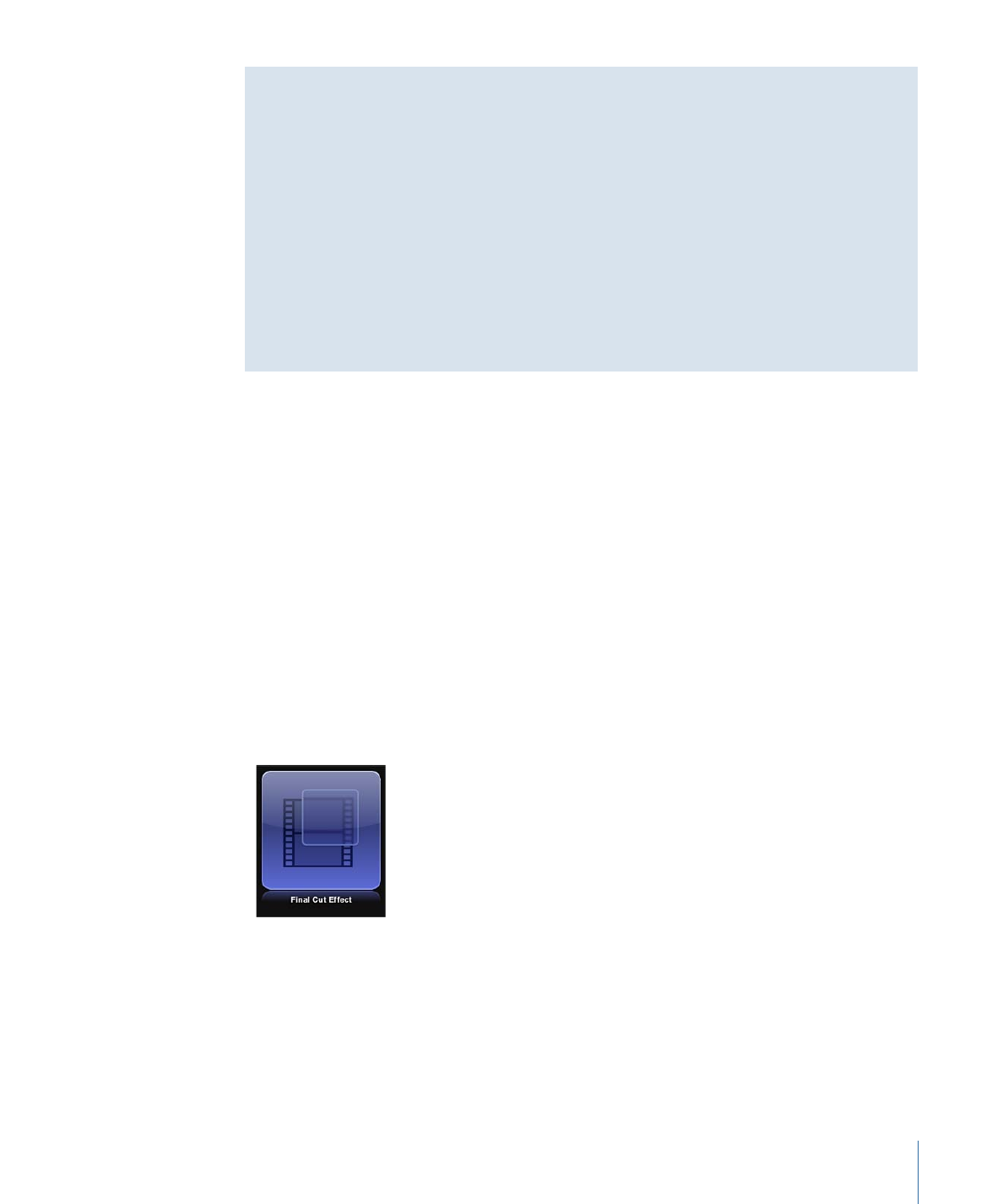
Creating an Effect for Final Cut Pro X
Use the Final Cut Effect template to create a custom effect for use in Final Cut Pro X.
For detailed information on the Project Browser, see
The Project Browser
. For information
on applying and editing effects in Final Cut Pro X, see Final Cut Pro X Help.
For an example of creating a Final Cut Effect that includes a rig, see
Advanced Example:
Creating an SLR Effect Template Using Rigging
.
To create a new effect template
1
In Motion, choose File > New From Project Browser (or press Command-Option-N).
The Project Browser appears.
2
In the Project Browser, click Final Cut Effect, then choose a project size from the Preset
pop-up menu.
Important:
Be sure to create the template at the highest resolution you will use in your
Final Cut Pro project.
3
Click Open (or press Return).
If the correct preset is already chosen, you can double-click Final Cut Effect in the Project
Browser.
505
Chapter 11
Creating Templates for Final Cut Pro X

A new, untitled Motion project opens, with the Effect Source placeholder layer selected.
4
To add a reference image to the Effects Source placeholder to preview your work, do one
of the following:
• From the File Browser or Library, drag an image onto the placeholder arrow in the
Canvas. When the pointer becomes a curved arrow, release the mouse button.
• From the File Browser or Library, drag an image to the Effect Source layer in the Layers
list. When the pointer becomes a curved arrow, release the mouse button.
Be sure to drag the image from the File Browser or Library to the placeholder. If you
accidentally place the image into a new layer, you can’t move it to the placeholder layer.
The image is added to the Effect Source layer, replacing the arrow graphic in the Canvas,
and is resized if it is not the same size as the project. The image is temporary media used
to preview the result of the effect you are building. It is not used in the Final Cut Pro X
effect.
5
Add filters or behaviors to the Effect Source layer to create a custom effect.
The filter and behavior parameters can be modified and animated. For more information
on working with filters, see
Using Filters
. For more information on behaviors, see
Using
Behaviors
.
6
To allow Final Cut Pro users to modify specific parameters, choose Publish from the
Animation pop-up menu of each parameter you want to make accessible.
Publishing a parameter makes its user interface control (the slider, checkbox, or dial)
available in the Final Cut Pro Inspector when the custom effect is applied to a clip.
Published parameters can be adjusted and keyframed in Final Cut Pro. For more
information, see
Publishing Parameters in Templates
.
Tip: In addition to publishing specific parameter controls, you can publish the blue
activation checkboxes that appear next to filter and behavior names in Motion Inspectors.
When you publish an activation checkbox (via its Animation pop-up menu), a
corresponding checkbox appears in the Final Cut Pro Inspector, allowing users to turn
the influence of that filter or behavior on or off. For more information, see
Publishing
Parameters in Templates
.
7
Optional: When you're satisfied with the custom effect you’ve built, you can remove the
preview image from the template by selecting the Effect Source layer, then clicking the
Clear button in the Image Inspector.
The temporary image is removed from the project.
8
Choose File > Save, then do the following:
a
In the save dialog, enter a name for the template.
If you don’t specify a name, the template appears in the Final Cut Pro Effects Browser
as “New Template.”
b
Choose a category from the Category pop-up menu.
506
Chapter 11
Creating Templates for Final Cut Pro X

You can also create a custom category. Categories appear in the Motion Project Browser
and the Final Cut Pro Effects Browser.
c
If needed, choose a theme from the Theme pop-up menu.
You can also create themes. Themes appear in the Motion Project Browser and the
Final Cut Pro Themes Browser. A theme is a metadata tag that helps categorize
templates. For more information on Motion Project Browser themes and categories,
see
The Project Browser
.
d
To retain unused media in the project (media or audio in the Media list that is not used
in the template), select “Include unused media.”
e
If you want a preview movie to appear in the Motion Project Browser, select Save
Preview Movie.
9
Click Publish.
The template and remaining media are saved and exported to the Final Cut Pro Effects
Browser.
For information about applying and editing effects in Final Cut Pro, see Final Cut Pro Help.